Floral foam alternatives
When deciding how sustainable a manufactured product is, we need to consider the product’s entire life cycle. This includes design, creation, manufacturing, transportation, use and disposal.
Why we must stop using floral foam
There is a good reason the Sustainable Floristry Network’s Design and Business Principles include ‘design without floral foam’ as a key action in Design out waste.
The latest science confirms that floral foam is bad for the environment. It is made from non-renewable petrochemicals, is a single use plastic, is harmful for animals and should only go in landfill. We need to stop using it as soon as possible.
It is surprising that it is still not banned, given the urgent need to remove this type of plastic from production. But floral foam has slipped past regulators for a long time and, until those regulations and laws have been updated, it is up to florists to take the lead.
Floral foam
- is plastic
- is single-use
- crumbles easily
- is made from petrochemicals
- disposal in landfill only
- harms aquatic animals
- does not support circular objectives
Going #nofloralfoam
There is no denying floral foam is convenient and cheap, and switching to alternatives is not necessarily easy for many people. A perfect replacement product does not yet exist and finding a perfect alternative that matches floral foam’s functions is not an easy task. It is important to understand that floral foam’s ‘invention’, was effectively a fluke: it was not designed for purpose — it was just a by-product from early foam manufacturing in the 1950s that happened to absorb water and hold stems at the same time.
However, floristry without floral foam is entirely possible. There is ALWAYS a much more sustainable option for celebrating flowers.
Committing to going #nofloralfoam starts with understanding why we must change. To make the change to going #nofloralfoam, florists need to adopt a new mindset – the ‘cradle to cradle’, or circular mindset, which starts with reconsidering design, and ends with redefining ‘waste’.
Using circular models
So how do we know what is better?
Across all manufacturing and packaging industries, a common objective in sustainability initiatives is shifting to circular models of product design.
In circular design, there is no waste. Products are designed to fit into one of two cycles: biological or technical. Biological-based products must be able to return to the earth in a harmless way and technical products and their component materials must be suitable for re-use or recycling. In circular models, everything goes somewhere, and nothing is designed for landfill.
The circular economy is based on three principles, driven by design:
eliminate waste and pollution, circulate products (at their highest value) and regenerate nature
❝ — The Ellen MacArthur Foundation
Plastics and floristry
Plastics can have a place in circular models, but it is complicated. The use of plastic must be considered in relation to the product’s function: is it an essential or luxury item? Is it single use, or designed for re-use? Are there other alternatives? Who is the likely end user of that product? Are there collection and reprocessing facilities set to deal with that product at the end of its useful life?
When there are recycling facilities, are they effective? While some plastics can be converted into other plastic products like fabrics or furniture, it is an extremely imperfect solution. Plastic waste is difficult to sort – one product often contains more than one type of plastic, and each must be processed in a different way. Contamination is a big problem and plastic degrades each time it recycled. In fact, only 9% of all the plastic ever produced has ended up as a new product.
Overall, there is universal agreement across the globe that we must drastically cut our dependence on plastics because of the impact their manufacturing and disposal is having on the natural environment. And as researchers are discovering, making biodegradable plastic is not the answer.
The idea of something being biodegradable seems good, until we learn that the word doesn’t mean much when it comes to plastic. The big problem with plastic is that it never goes away – it just ‘biodegrades’ into smaller pieces, eventually becoming microplastics, which are smaller than 5mm. These tiny fragments become invisible, but they never really disappear and, once in the environment, can cause health problems for both humans and animals.
We need to ask:
- Where did this product come from?
- Where is it going once it has reached the end of its useful life?
Asking questions about ‘eco-friendly’
When we consider the ‘eco-friendliness’ of the product, we need to consider its entire life-cycle, from manufacture, through to disposal. For this exercise, we are taking questions of convenience and functionality out of the discussion and just looking at the products from an environmental impact perspective.
Thinking about how floral foam is regularly buried with coffins is a great point of reference for considering manufactured alternatives. That foam is going into the earth. Once in the earth, those materials can travel through the soil and the water underground as the particles become smaller. Burying in a grave is burying in the natural environment, just in the same way that a plastic bottle dropped in the water on one side of the world can wash up on the shore of a country on the other side.
We don’t always know the answer to the following questions, but it doesn’t mean we can’t get in the habit of considering them.
Questions to consider:
Start-of-life:
- What type of materials is the support made from?
- Are these materials renewable?
- Are they toxic in any way?
- How is the product manufactured?
Design:
- Does it design out waste and pollution?
- Does it keep products and materials in use?
- Can it contribute to regenerating natural systems?
End-of-life:
- Can the material be re-used, recycled or composted, or will it end up in landfill?
- Realistically, will the material be reused, recycled or composted? Can it easily find its way into the correct recycling or waste system?
Floral foam alternatives
Here we are taking a look at four alternatives to floral foam that are currently commercially available in many countries.
◆ OshunPouch
The OshunPouch is made from renewable, plant-based materials. The external membrane is made from a plant-based PLA bioplastic membrane and the filling is coconut coir mixed with a plant-based gelling agent to absorb water.
The external membrane is certified ‘Home Compostable’ according to European TUV standards.
Start-of-life: Renewable, all-natural plant-based resources. Non-toxic.
Design: Certified home-compost friendly by European Standards. Supports a circular biological cycle. Supports all three circular principles: designs out pollution, keeps materials in use and can help with regenerating natural systems.
End-of life: Compost with flowers, can safely be buried with a coffin.
Website: OshunPouch
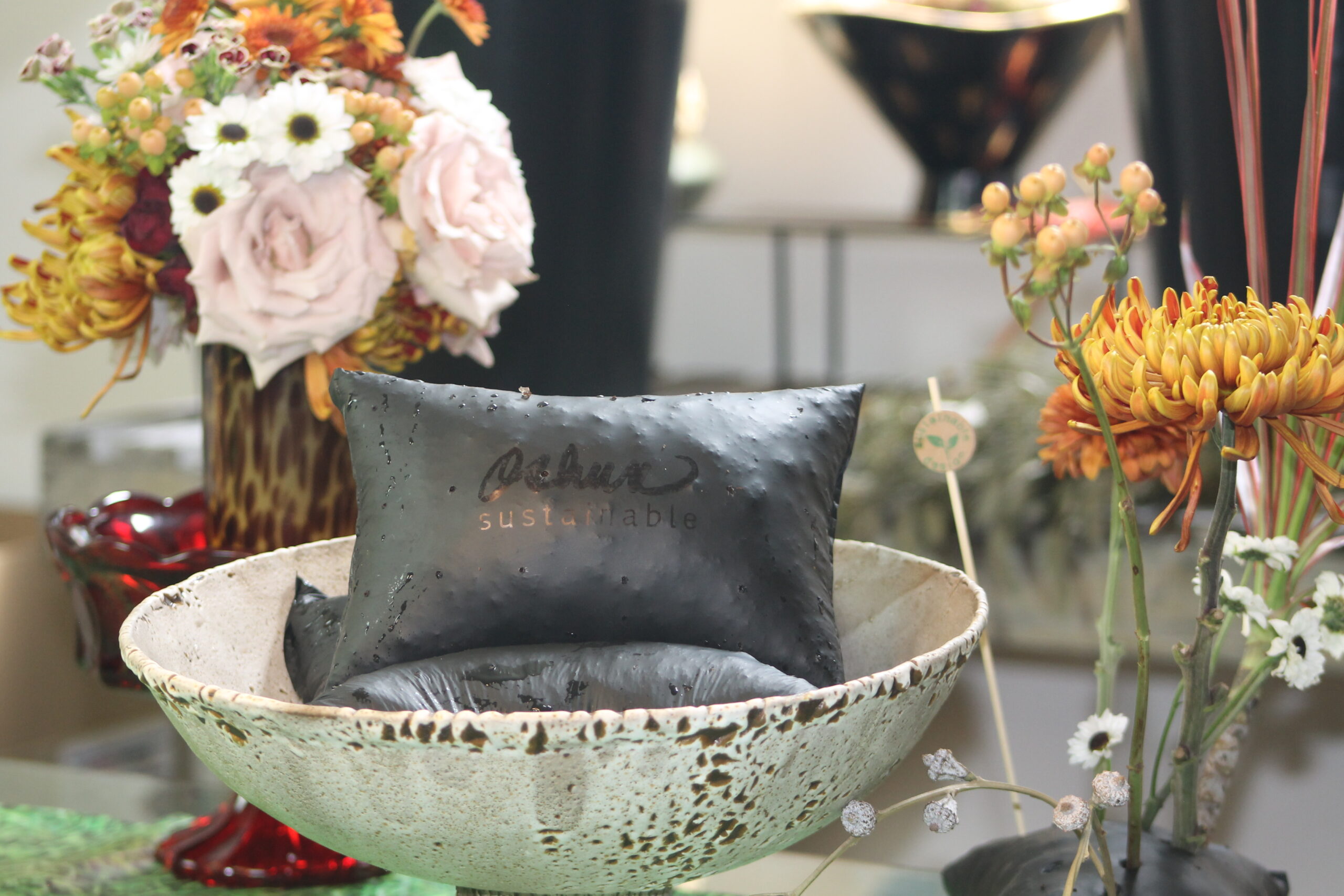
The OsunPouch is a closed pouch made from a plant-based membrane filled with coconut coir that expands when hydrated.
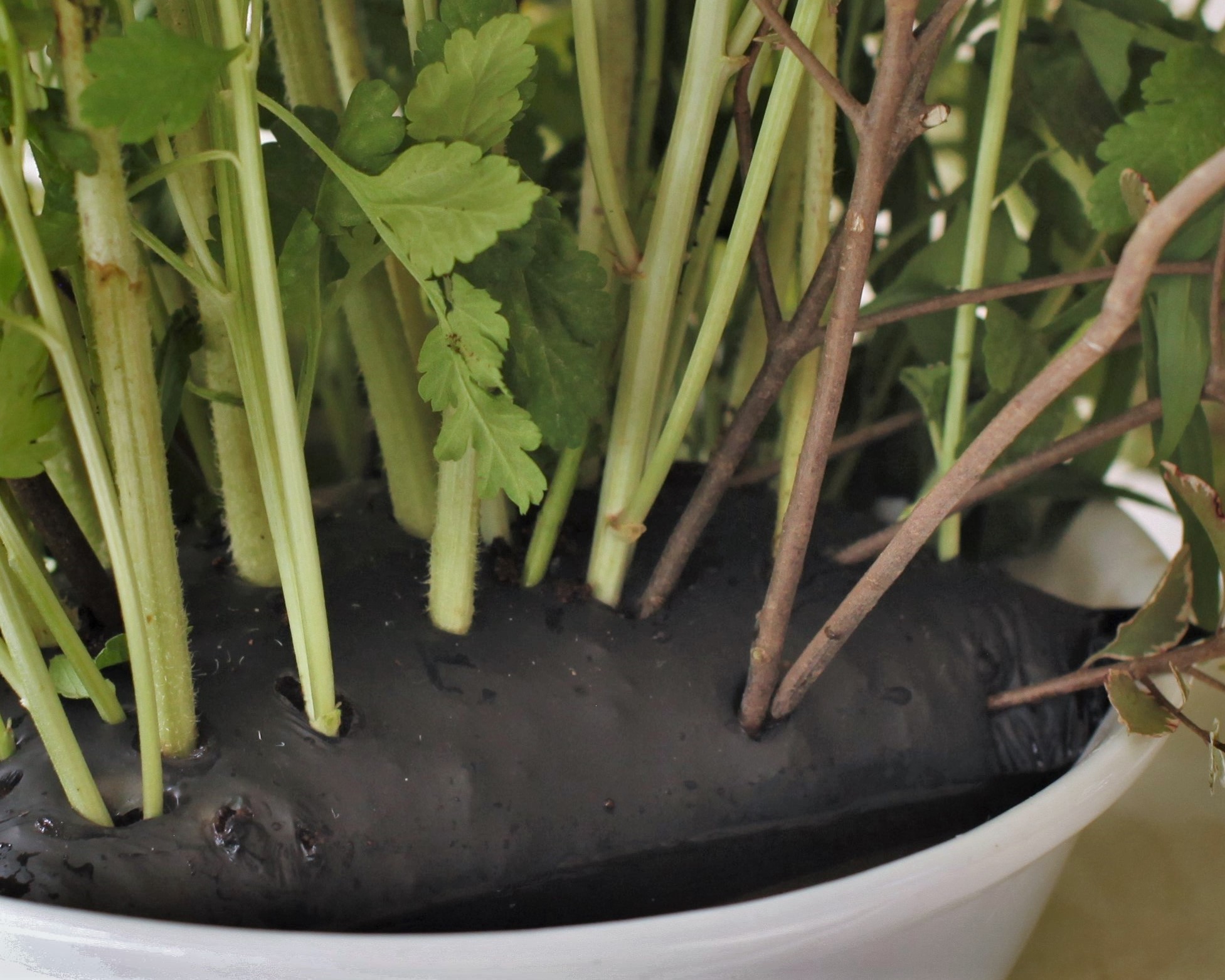
The OshunPouch supports stems in a similar way to foam, but has shorter term hydration capabilities.
◆ Earthwool
Sideau by Agrawool
This product is made from rockwool, a mineral fibre made from 97% powdered basalt rock spun into fibres at high heat with the addition of a binding agent made from sugar.
SFN Advisor Professor Ian Rae, sees a great benefit in moving away from a synthetic petrochemical product to a naturally occurring mineral-based material because at the end of its useful life, the product is simply adding to what already exists in soil.
“This is a non-toxic, environmentally benign material made from natural materials,” says Professor Rae. “Once the binding agent breaks down, most likely as function of biodegradation, the product will become rock dust and simply add to the soil”.
Professor Rae says that if the material escaped into the natural environment through wastewater or incorrect disposal, it would not pose an ingestion risk to animals in the same way as plastic.
Start-of-life: Mostly mineral (rock, non-renewable) with sugar-based binder (renewable). All natural materials, non-toxic and non-polluting.
Design: Energy intensive manufacturing process.
Can be reused for plant propagation or harmless if broken into small pieces and added in small amounts to composting systems. Cannot be certified compostable as it is a mineral product — the rock won’t biodegrade, but the binding agent will. After biodegradation, rock dust remains which can add nutrients to a composting system.
Circular considerations: Designs out pollution.
End-of life: Inert/non-toxic addition to landfill, can safely be buried with a coffin.
Note: Since the development of this product by Agrawool, multiple competing products have appeared on the market. However, not all products contain the ‘Ecose’ binding agent. Having a biodegradable binding agent is what makes the ‘brick’ form break down over time, leaving the rock powder.
Website FAQ: Sideau
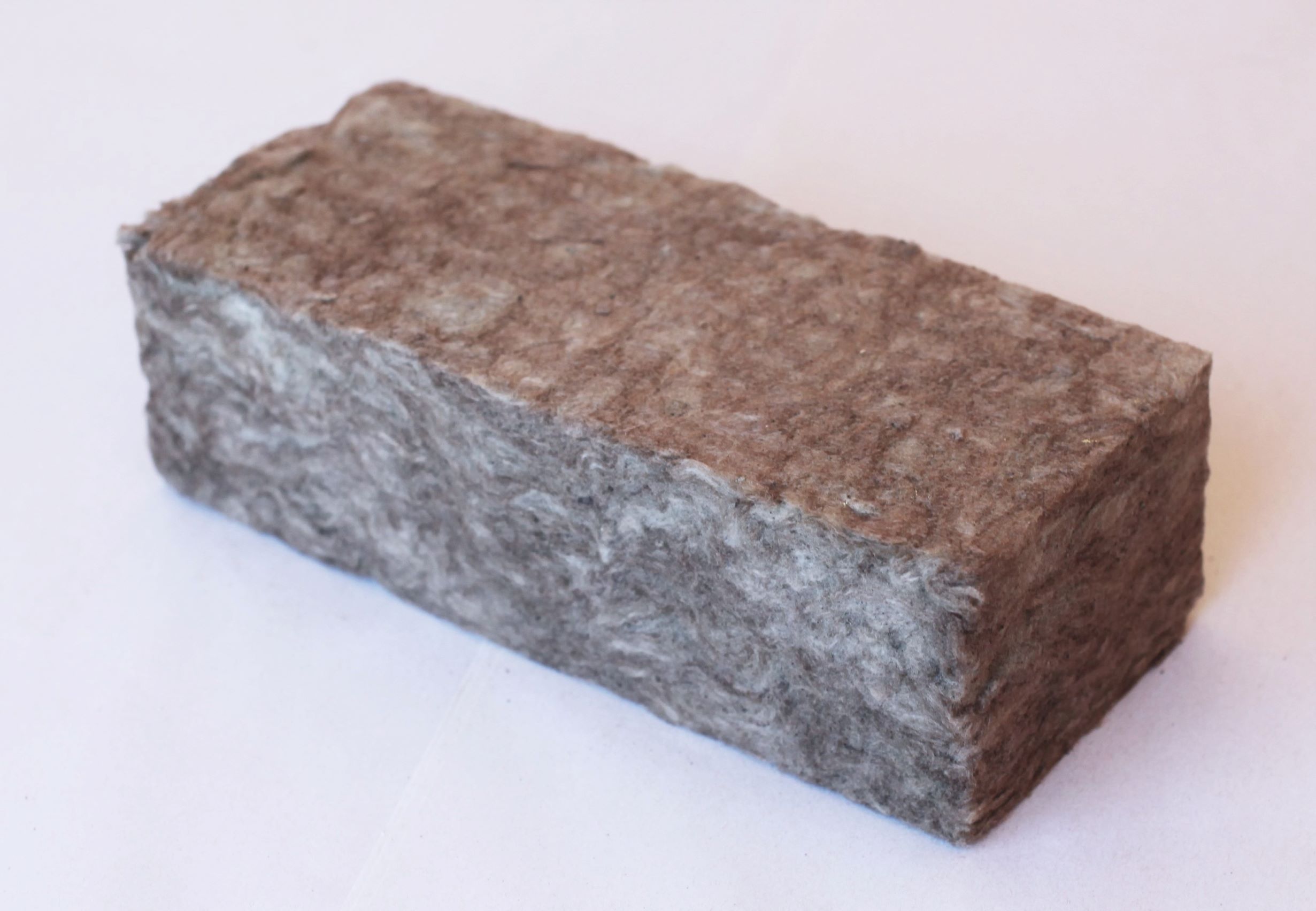
Sideau earthwool is made from powdered rock that is heated up, spun into fibres like cotton candy and pressed into a block.
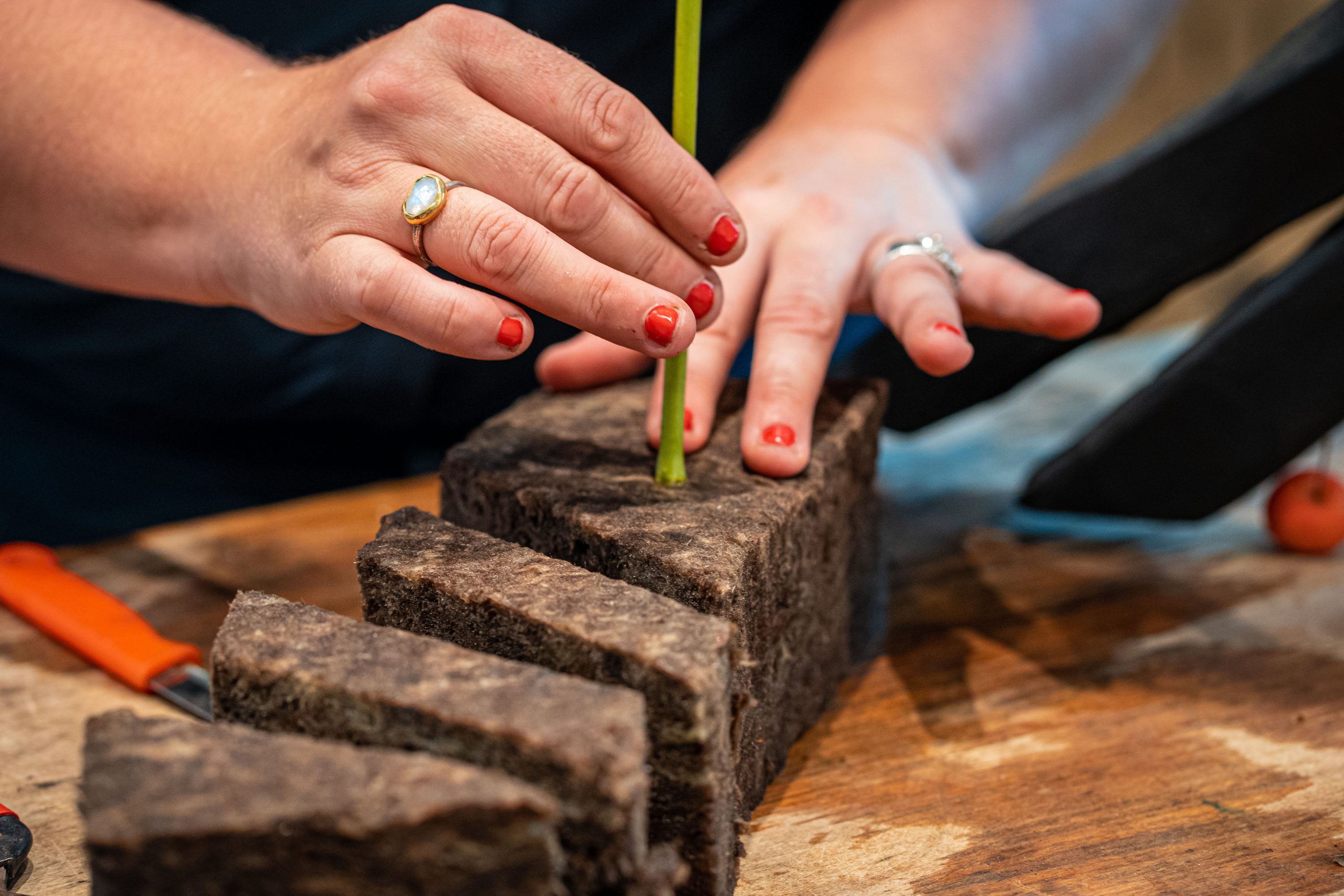
Sideau can be cut into different shapes and safely buried with a coffin.
◆ Bio Floral Foam
Manufacturers Smithers Oasis have produced a product known as Bio Floral Foam – which is essentially a traditional plastic foam with a biodegradable additive.
“Products like this can be even more damaging if they end up in the environment as they turn into microplastics faster,” says Dr Thava Palanisami, a lead researcher on microplastics at the University of Newcastle, Australia. “The problem is that if the particles are released in the environment, they will not meet the conditions needed to completely break down the plastic, and the material can be taken up by animals in the original form.”
A recent independent study about the impacts of floral foam on aquatic animals by RMIT University in Australia demonstrated that the “biodegradable” Bio Foam is very similar in chemical composition to regular floral foam. It was also shown to leach more toxic compounds into the water than regular foam. The study also showed that the material was eaten by aquatic animals with a range of feeding habits and that it is harmful for their health.
Start-of-life: Non-renewable resources. Petrochemical plastic with plant-based additive. Manufactured by refining oil and creating a synthetic plastic foam.
Design: Creates waste, is a single-use plastic and has been shown to harm animals.
End-of-life: Landfill only. Produces methane when decomposing. Cannot safely be buried with a coffin. Makes separation of compostable plant material very difficult because removed stems are contaminated with plastic.
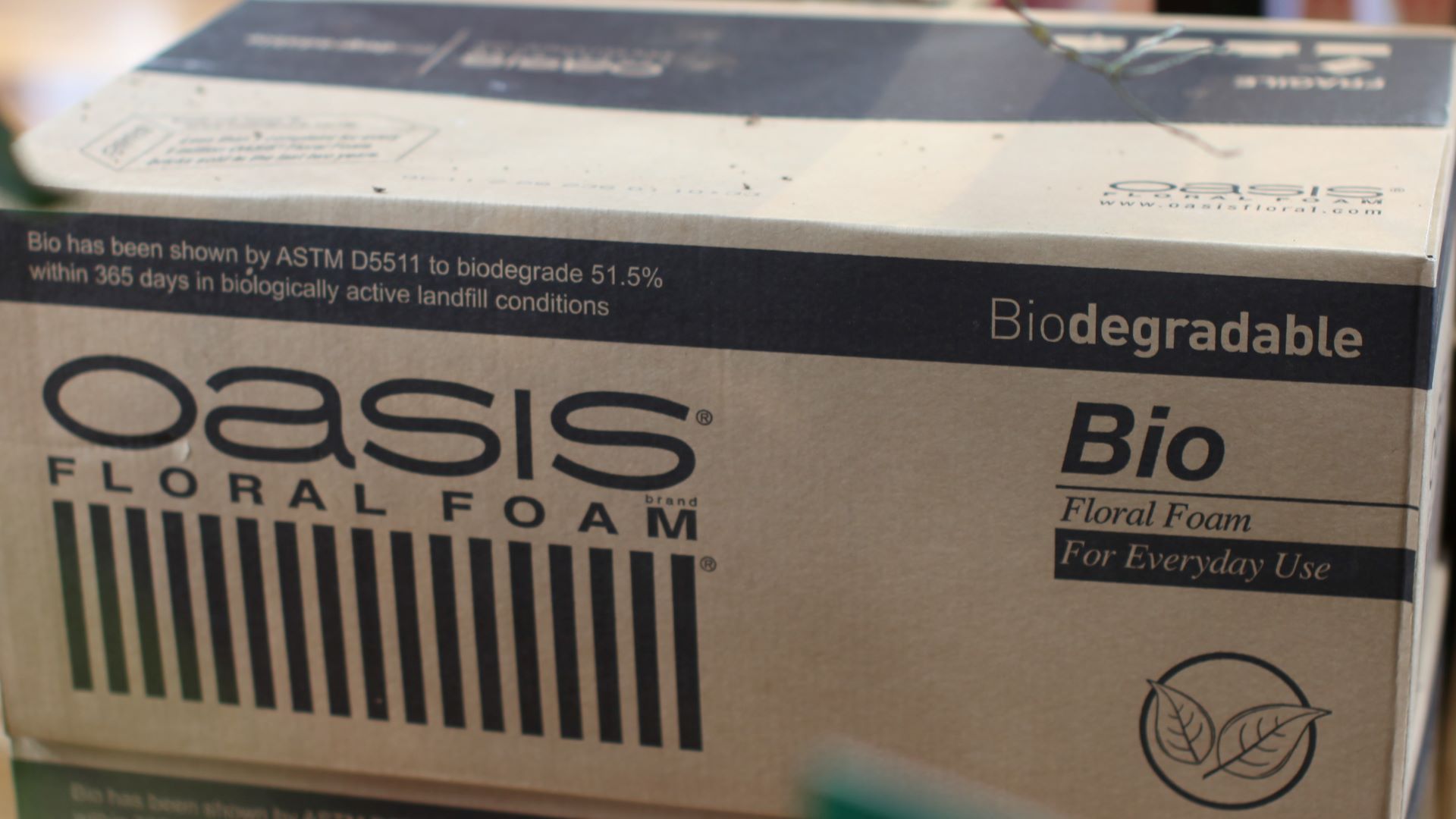
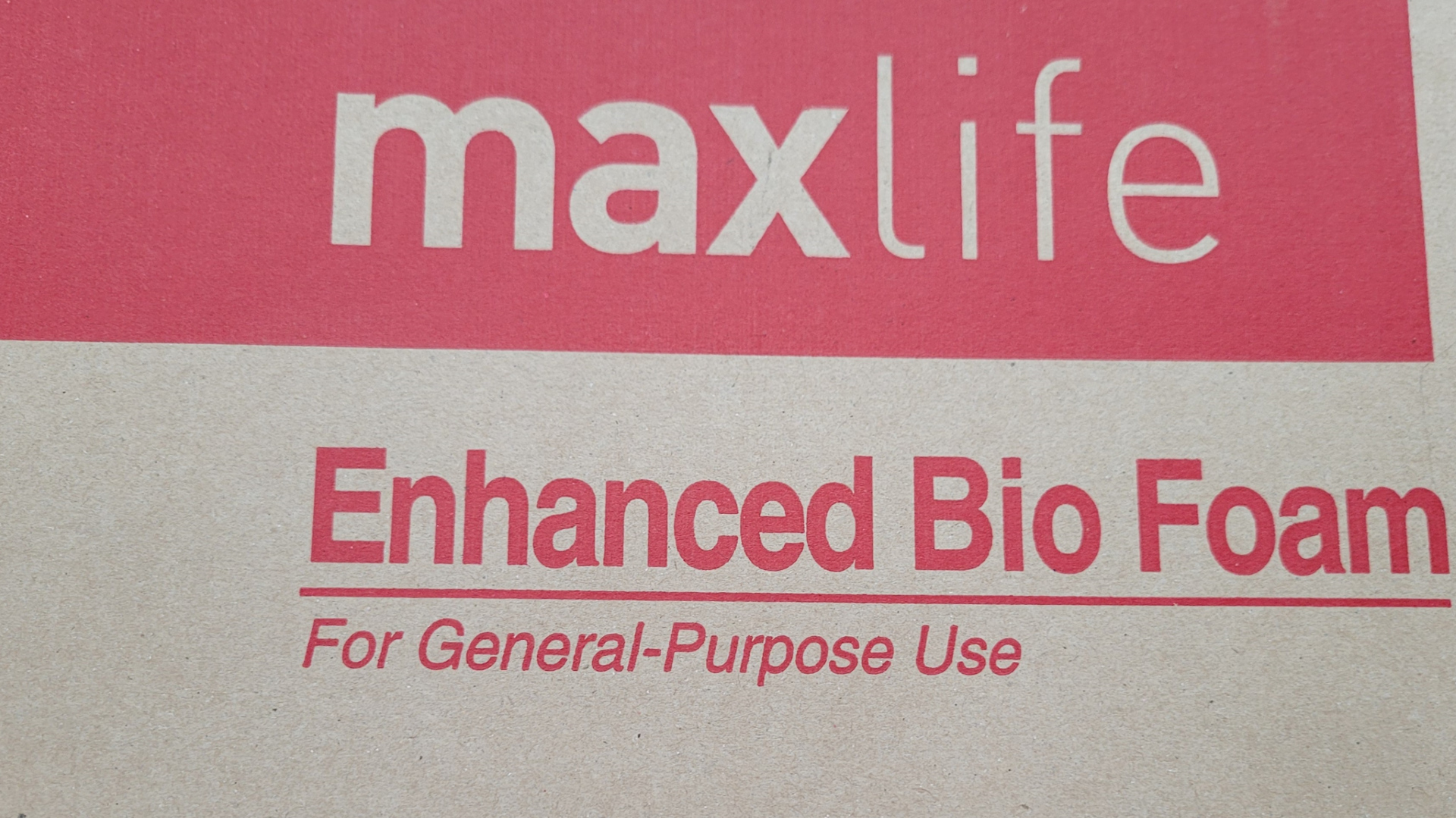
◆ TerraBrick
According to a press release issued by product manufacturer Smithers Oasis, the TerraBrick is “made with plant-based, renewable, natural coir and a compostable binder, OASIS® TerraBrick™ Floral Media has been certified OK compost HOME and OK compost INDUSTRIAL”. However, the company advises that the tray containing the products is not compostable and must be recycled with paper/cardboard.
Start-of-life: Renewable, plant-based, Non-toxic.
Design: Media is home-compost friendly. Supports a circular biological cycle. Designs out pollution.
End-of life: Media is certified home and industrial compost friendly, but base tray must be recycled. Not enough information available to determine whether it can safely be buried with a coffin/if or if base is truly biodegradable.
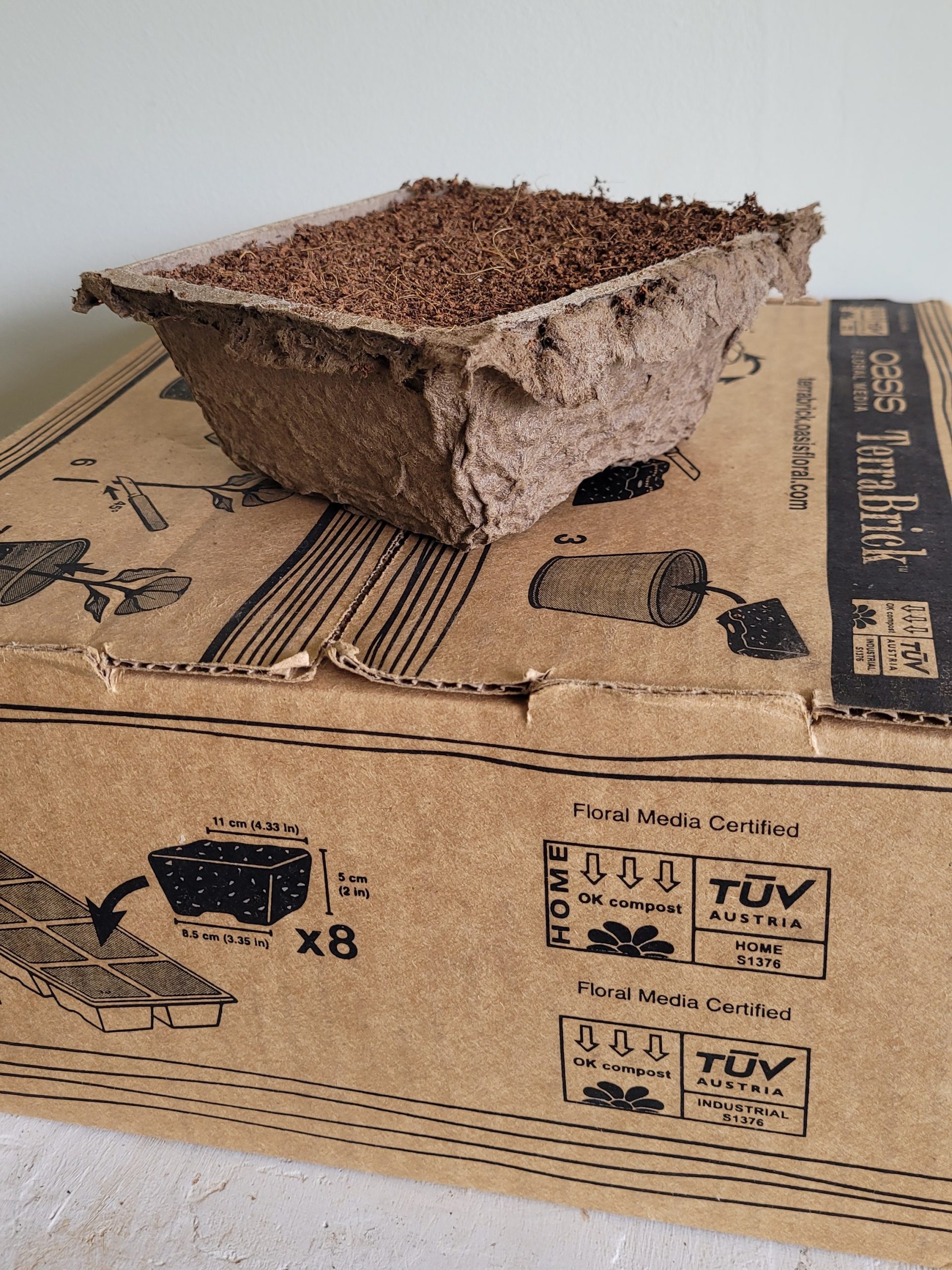
The TerraBrick media is made from Coconut coir and is certified home compostable.
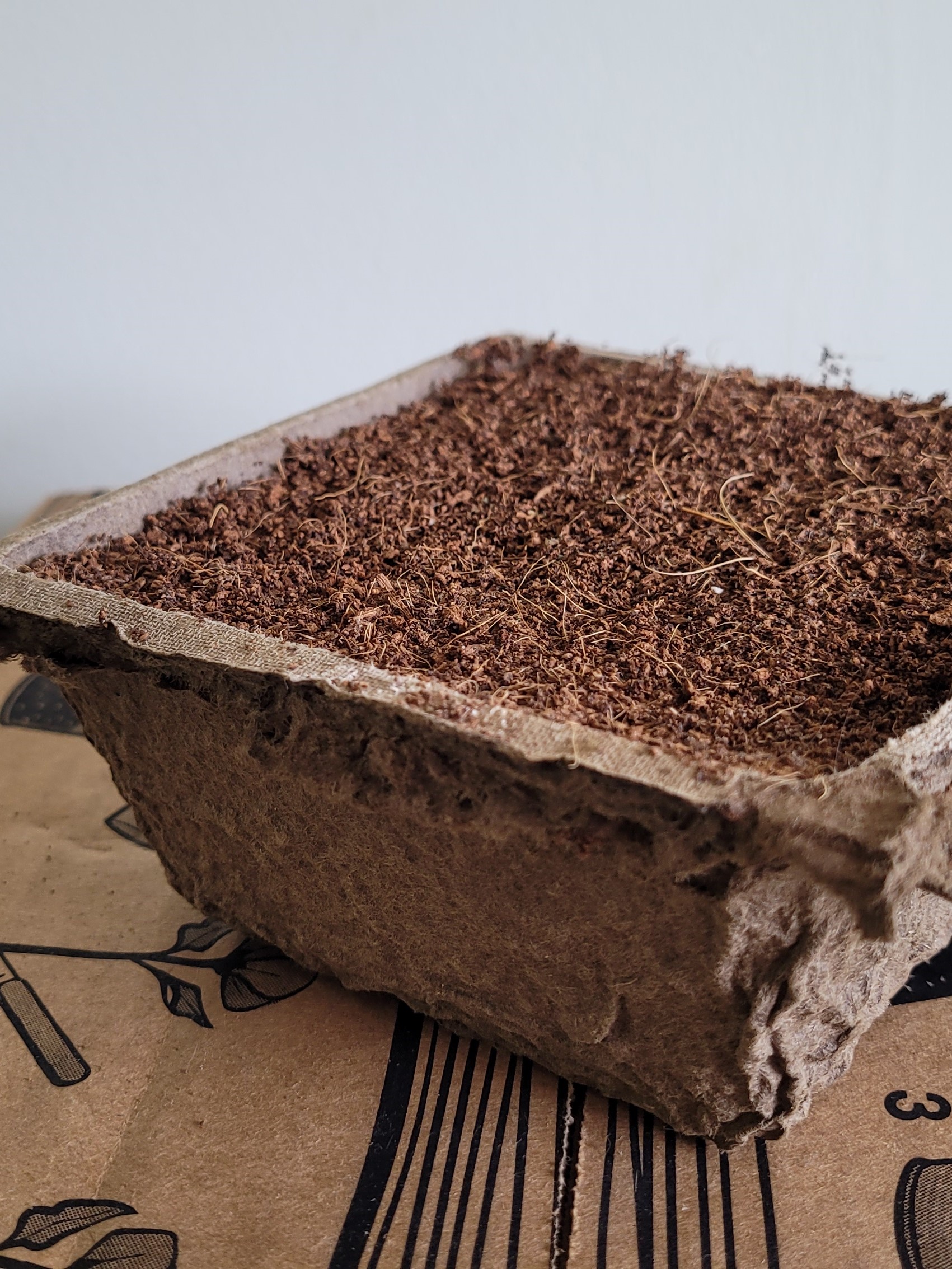
The cardboard container around the design media is to be recycled.
Other useful tools for #nofloralfoam
◆ Hand-tied and in-vessel arrangements.
Many florists agree that the secret to successful foam-free design is mastering hand-tied bouquets and vase arrangements. In these designs, there is no need for additional support products. Rather, the artistic use of foliage and flowers are used for support. Finding balance and control of the materials comes through practice and familiarity.
Mastering both techniques will take florists a very long way, especially in the world of events and retail. Ultimately, the majority of cut flower arrangements are made as hand-tied or straight flower bunches that are placed in a vase of water. A hand-tied or vase-arranged arrangement tied-off and placed into another vessel offers the smallest environmental footprint from the perspective of sundries because we are not relying on additional manufactured goods and can avoid producing waste through the choice of wrapping used.
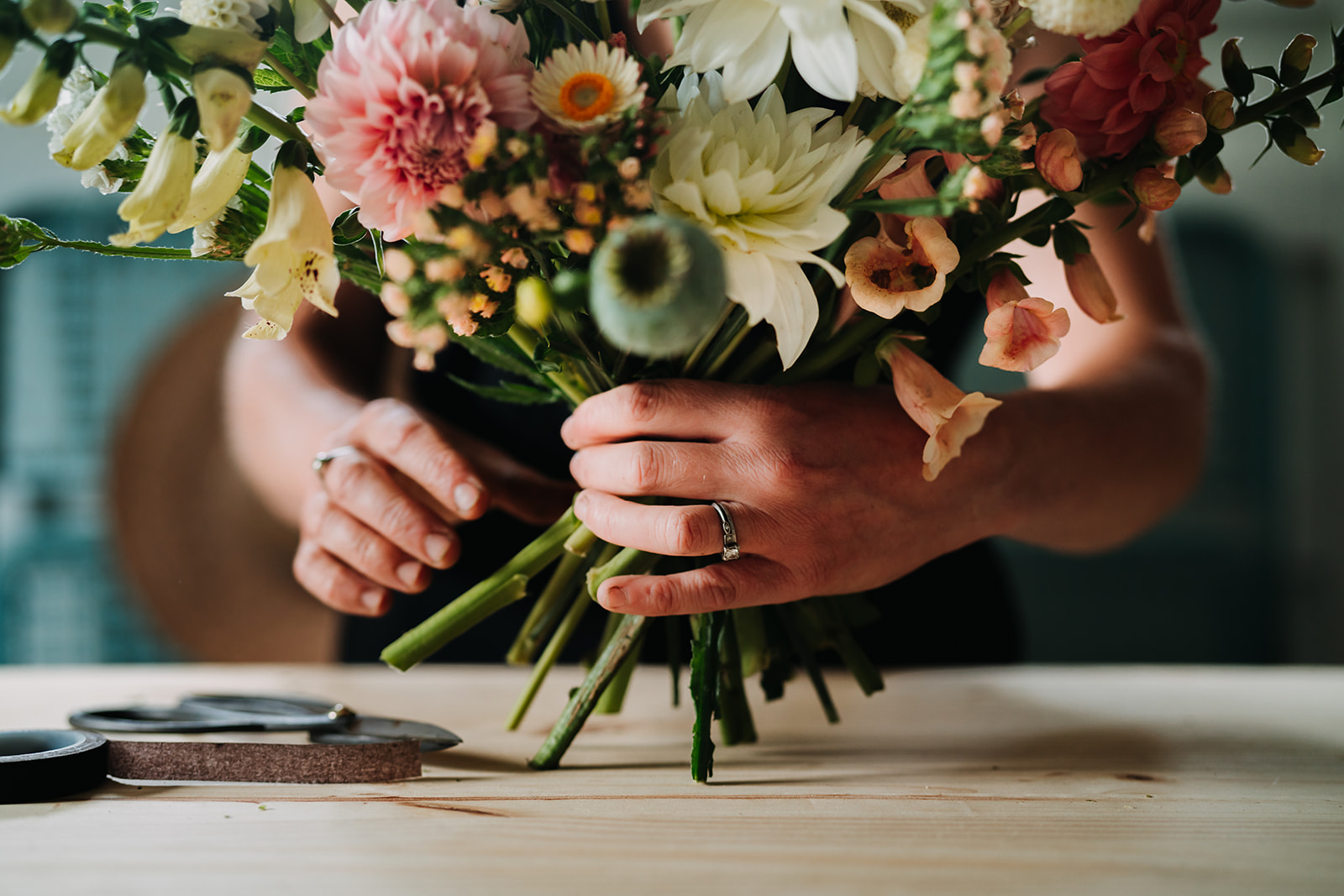
Hand-tied arrangements can be placed inside a reusable vessel or vase. Image: Little Farmhouse Flowers, US.
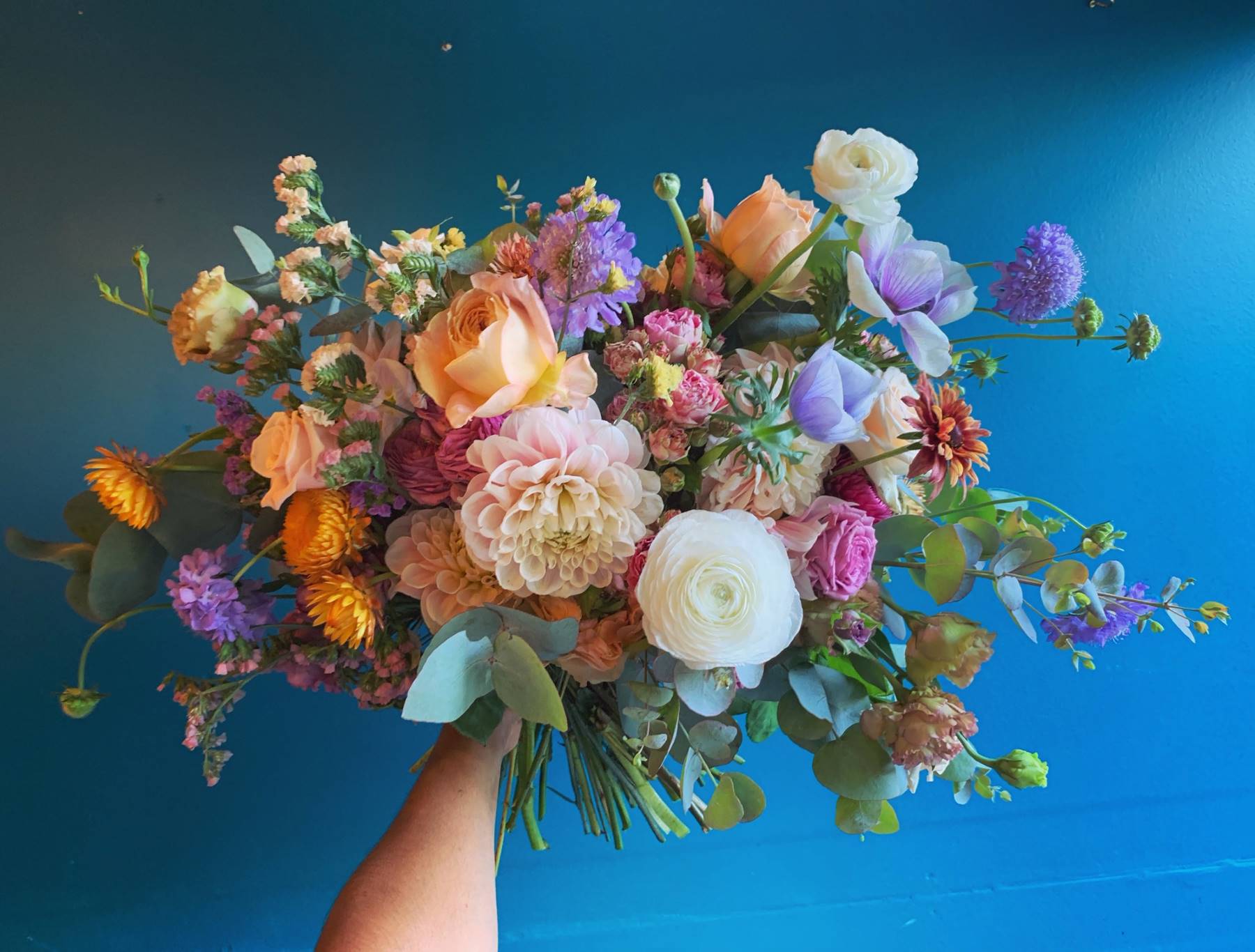
A florist builds the bouquet to a particular shape with skilled placement of flowers and supporting foliage. Image: Gorgeous and Green, US.
◆ Chicken wire
One of the most popular in-vessel supports is chicken wire. The wire is rolled into a loose ball to create a matrix to support stems under the water line. It works best in opaque vessels where the wire can’t be seen.
Chicken wire is usually either galvanised (coated with a zinc-based compound to stop rust) or plastic coated.
If in soil or water, steel wire will eventually rust away and return to compounds found in nature. As it is not designed to be under water, steel wire will rust faster than if used for its intended purpose as a fencing wire. However, while the plastic-coated version might prevent rusting, the product will produce microplastics as the coating deteriorates. Galvanised wire will not.
At the end of its life, chicken wire can be recycled with scrap metal, even if rust.
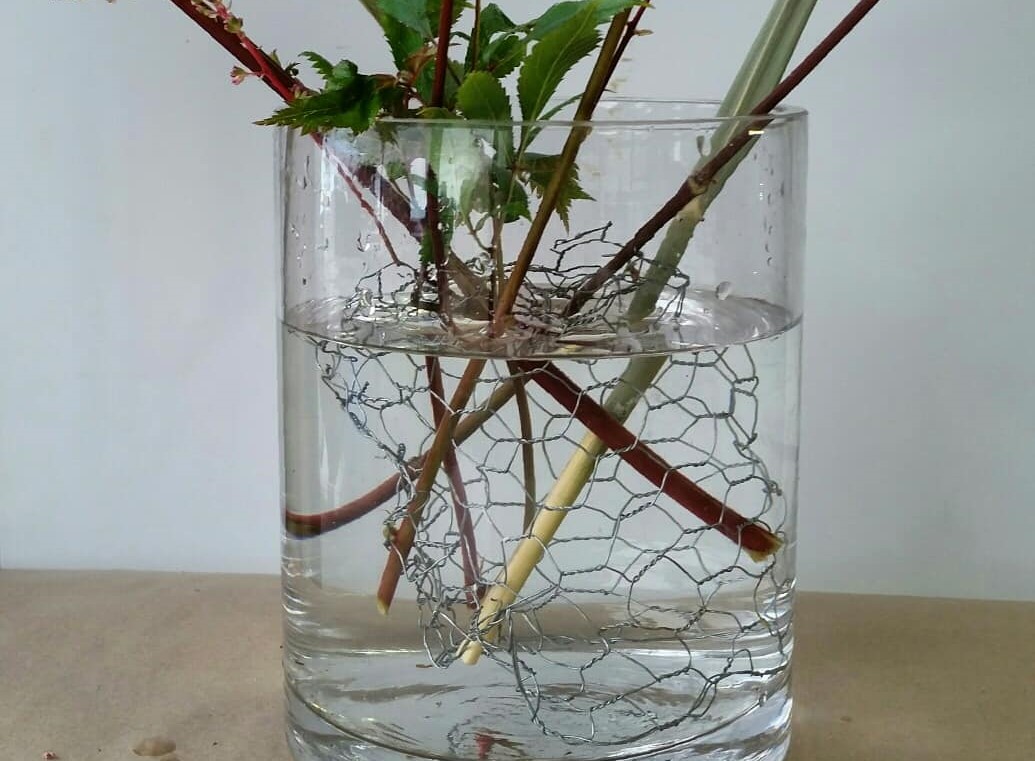
A loose scrunch of finer bird wire under the water to support stems.
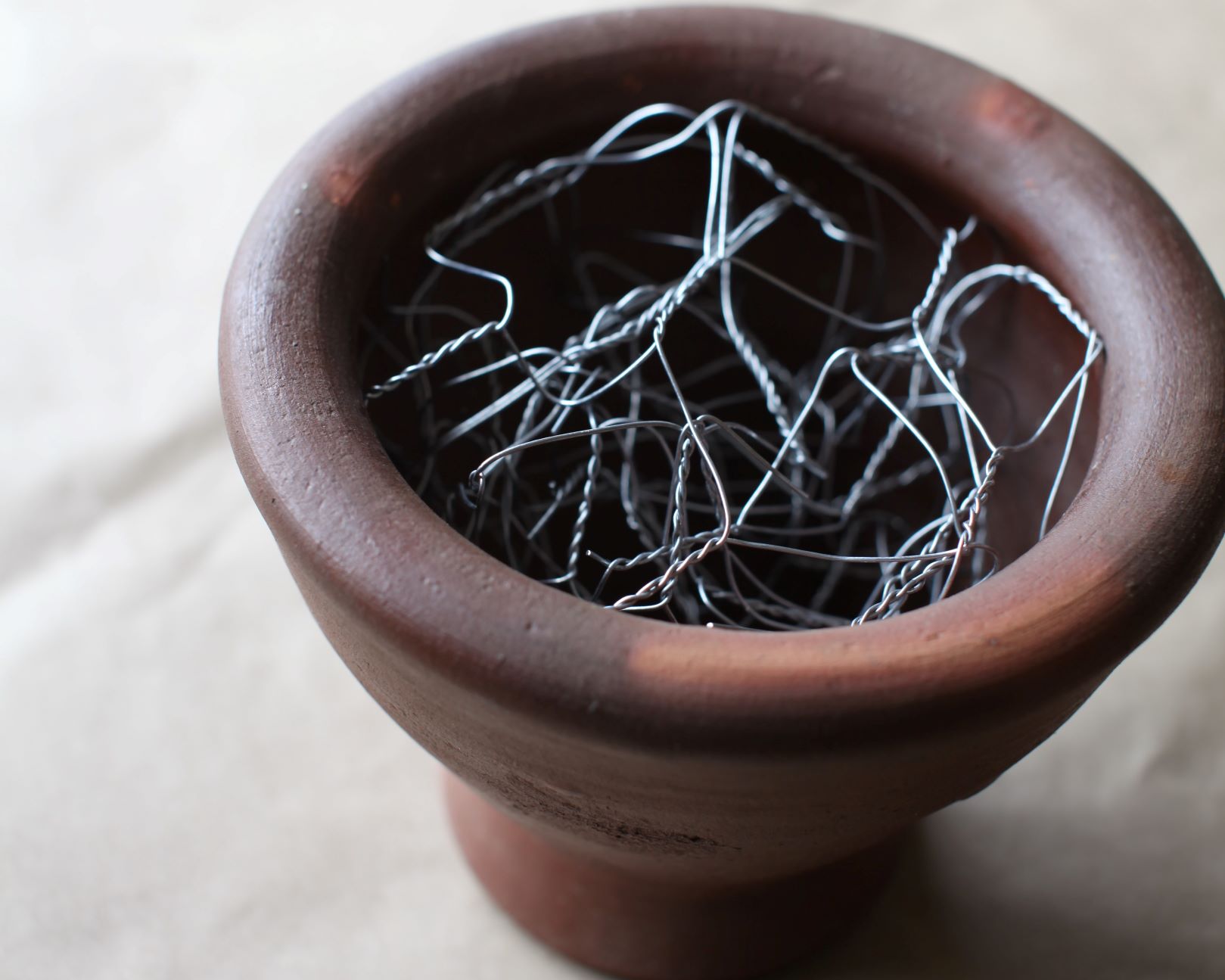
A ball of chicken wire under the water to support stems.
◆ Kenzans /spiked flower frogs
Traditionally used in Ikebana, kenzans, otherwise known as ‘flower frogs’ provide support for a floral arrangement through the use of a base plate with upward facing pins. The position of the stem is maintained by pushing the stem down into the pins – with the kenzan sitting beneath the water line.
Kenzans are designed for re-use over a long period of time. At the end of their life they can be recycled with scrap metal.
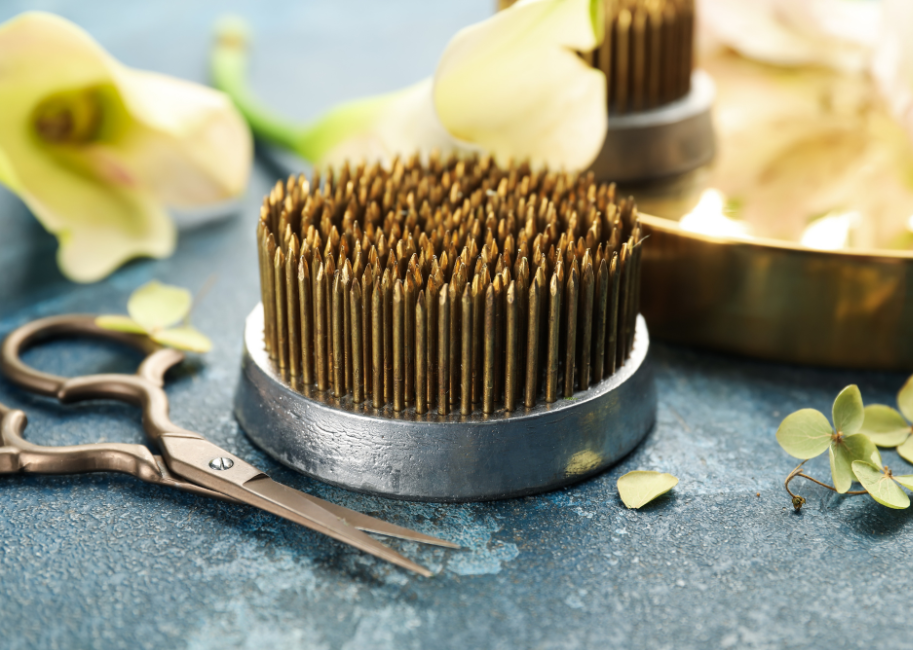
Kenzans, or spiked frogs.
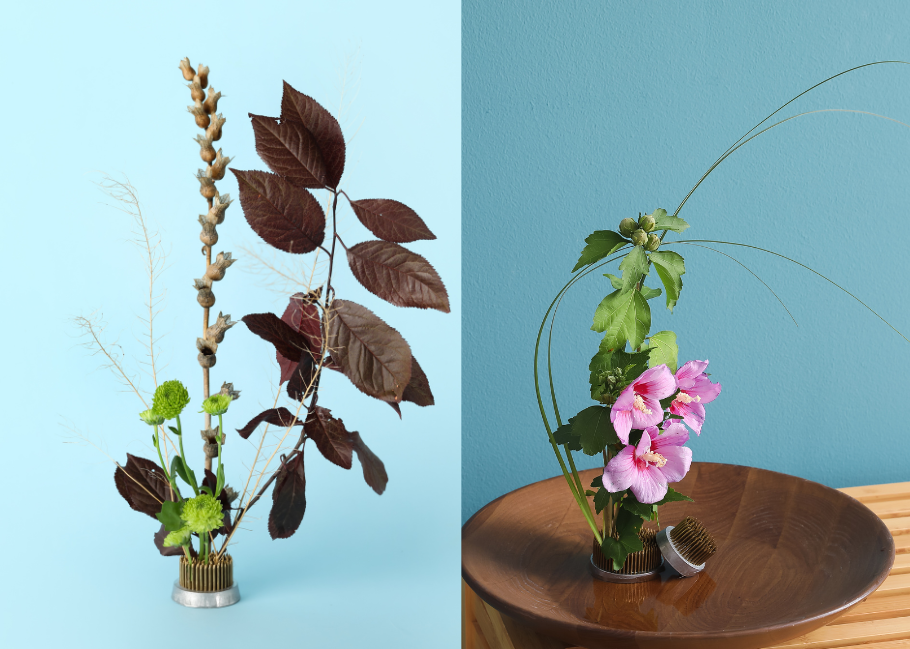
Spiked kenzans demonstrating stem hold.
◆ Hairpin holder frogs
Flower pins work in a similar way to kenzans but instead of spikes, the bases use metal ‘hairpins’ to hold the flowers in place.
Hairpin holders are designed for re-use over a long period of time. At the end of their life they can be recycled with scrap metal.
Website: FloralGenius
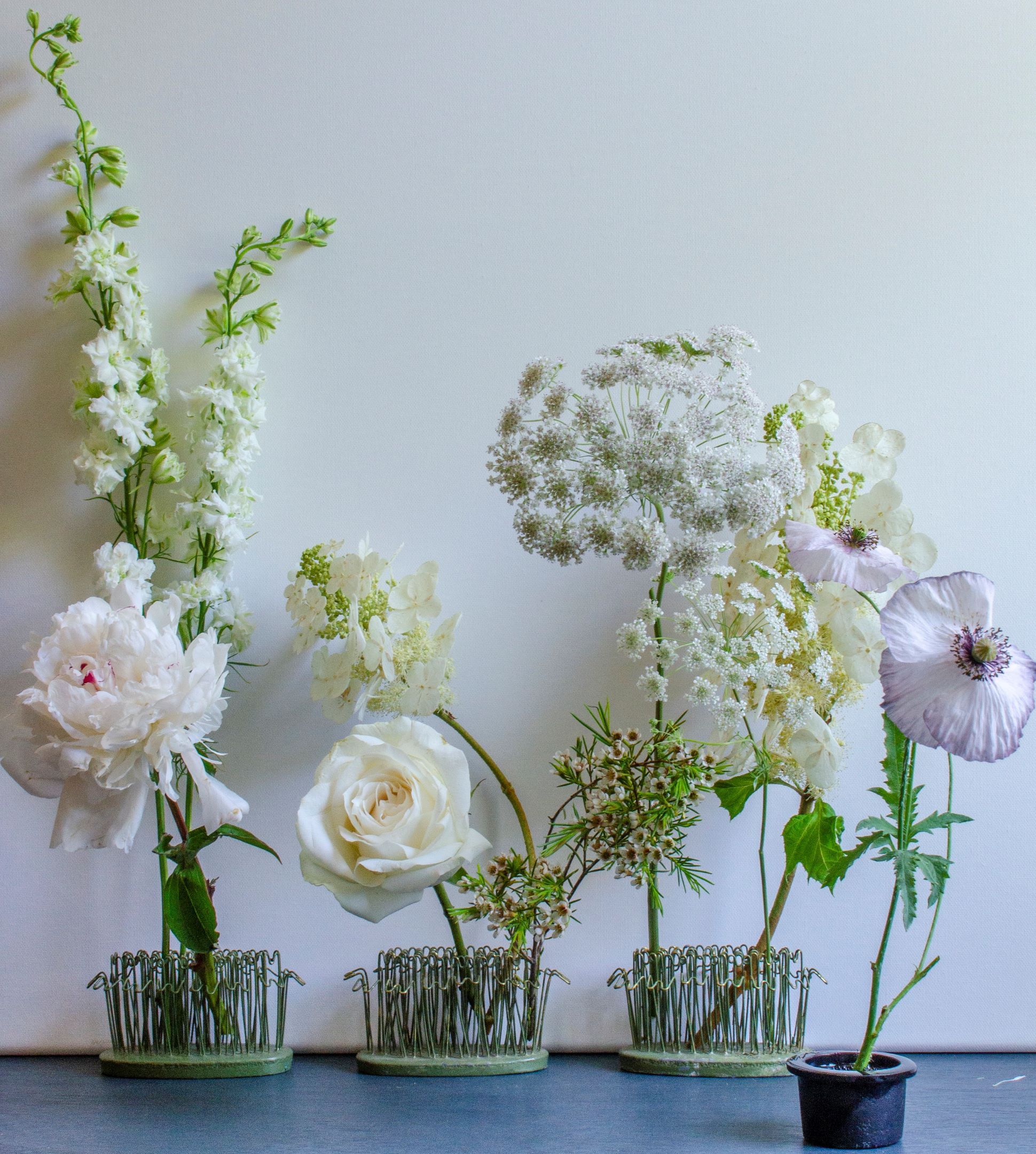
Hairpin holders by Floral Genius, US.
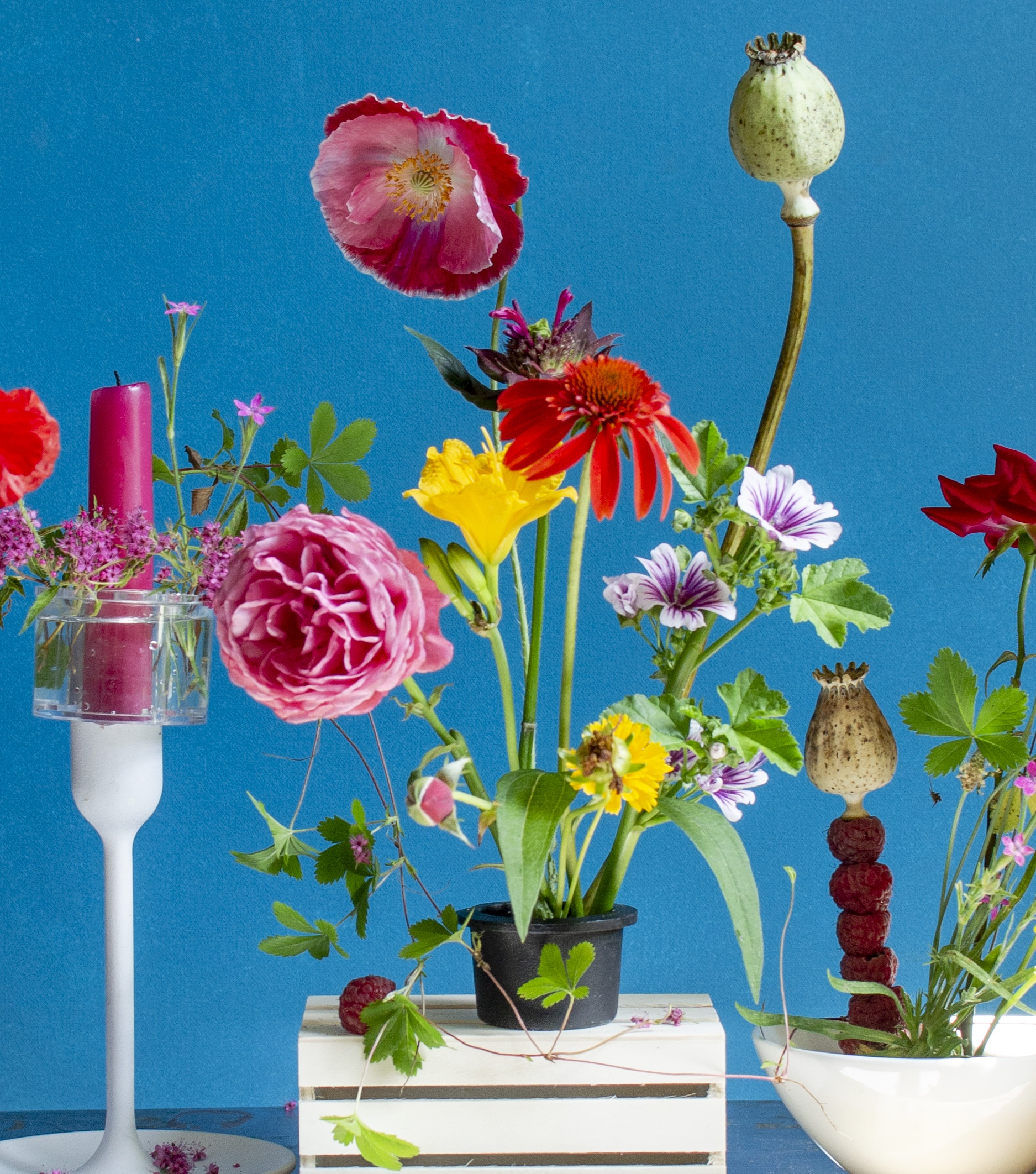
Spiked cups by Floral Genius, US.
◆ Eco-wraps
Although these wet-pack products do not offer support functions in the way that floral foam does, they do offer hydration support to cut flowers.
Website: Ecofresh Bouquet
◆ A Guide to Floral Mechanics
A current and simple technical reference available for florists is A Guide to Floral Mechanics by Sarah Diligent and William Mazuch. This step-by-step guide is especially handy for new florists or those wanting to transition to foam-free design. With an emphasis on planning and preparation, the approach to supporting mechanics allows for the expression of all styles of floristry.
Website: A Guide to Floral Mechanics
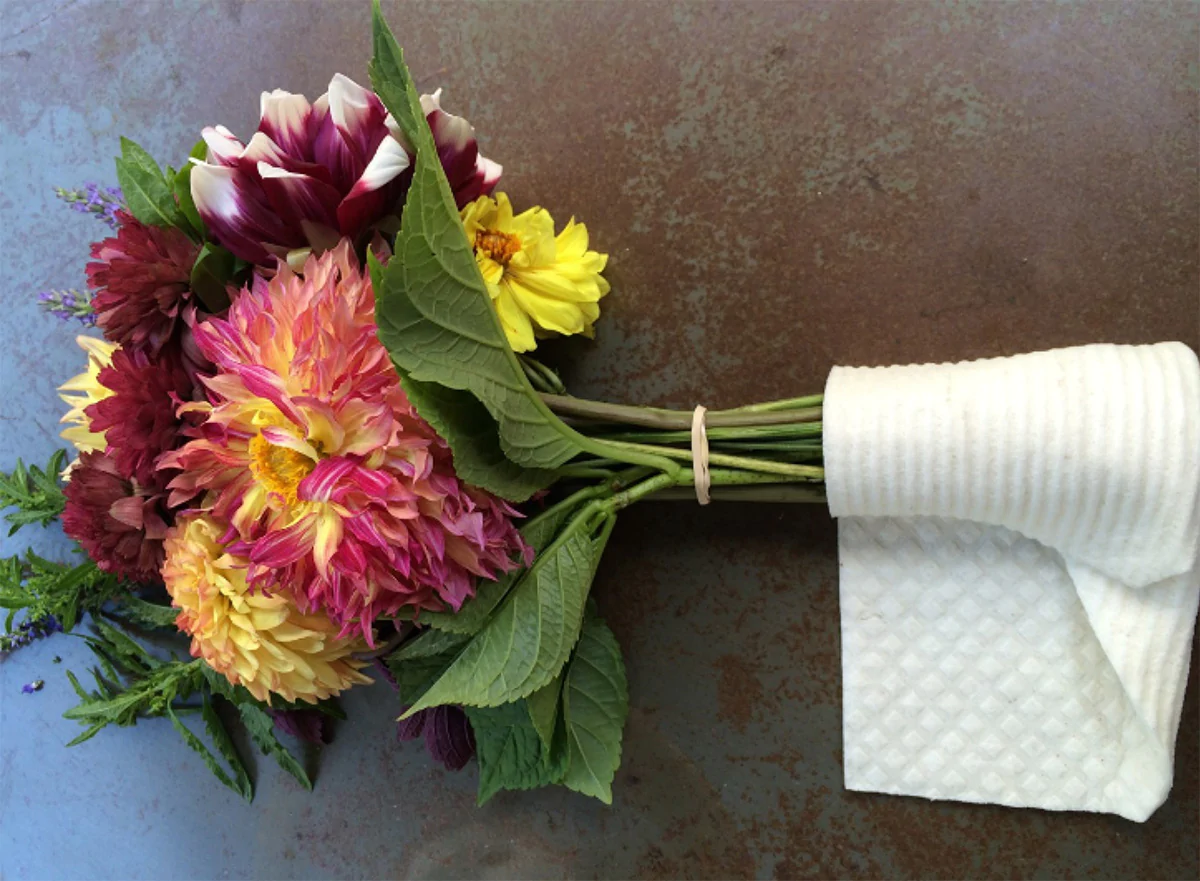
Ecofresh bouquet wraps.
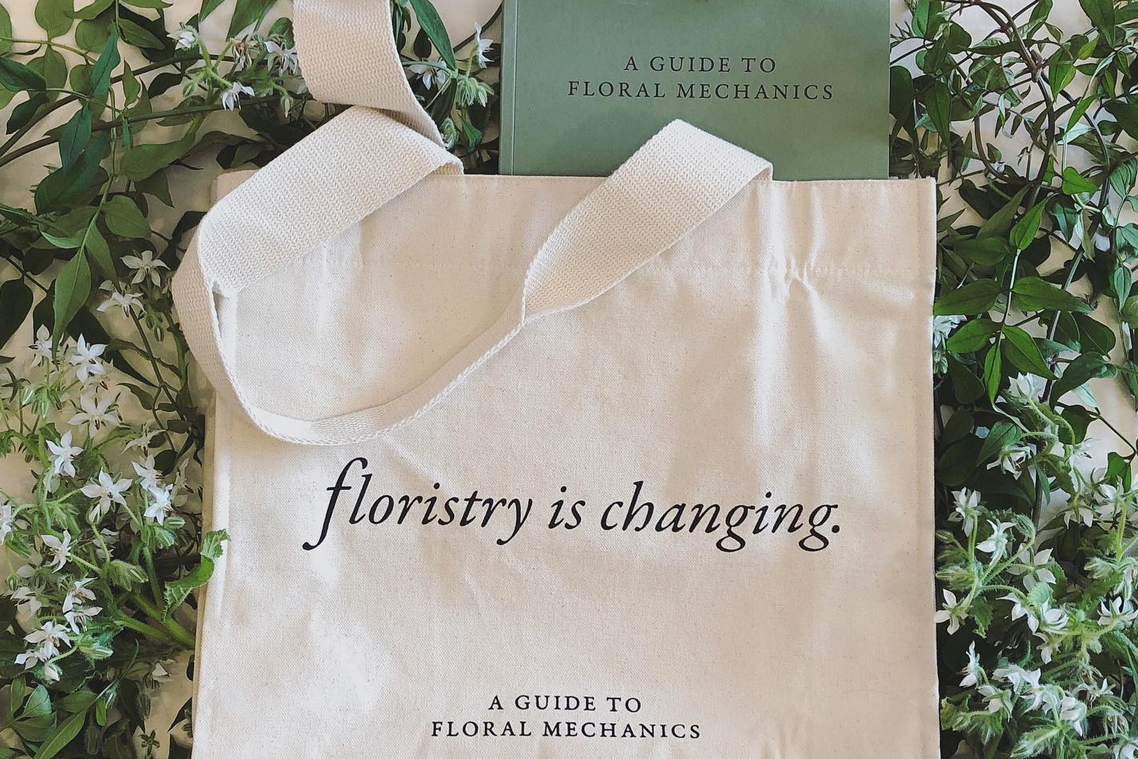
A Guide to Floral Mechanics.